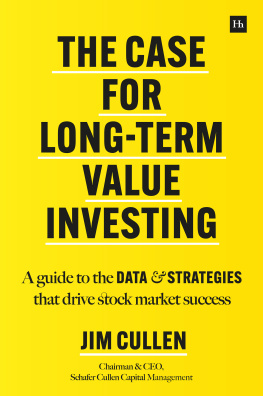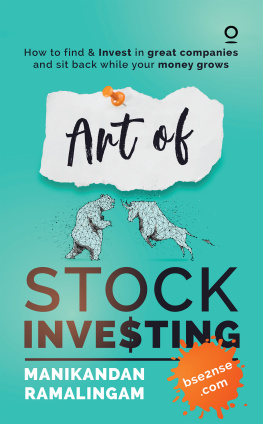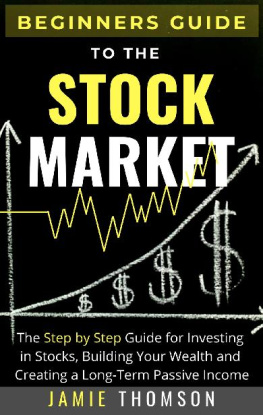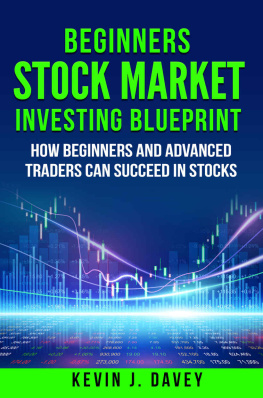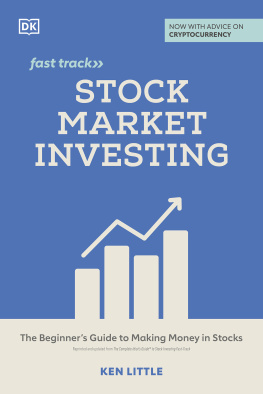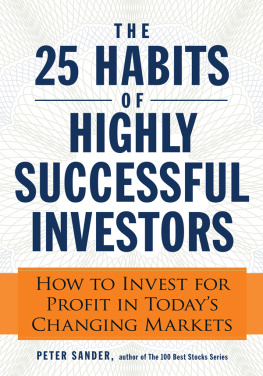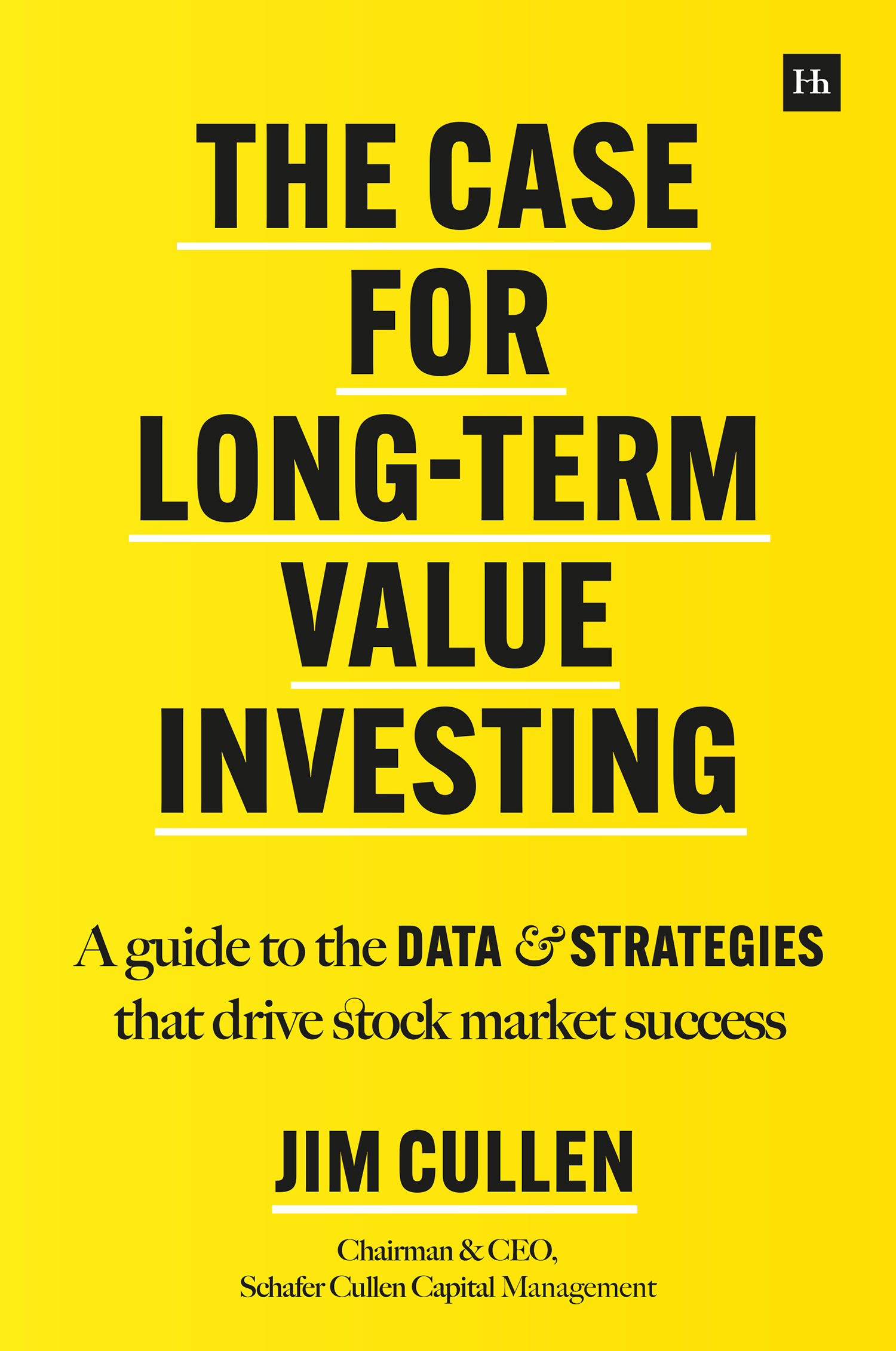The Case for Long-Term Value Investing
A guide to the data and strategies that drive stock market success
Jim Cullen

Contents
The Case For long-term Value Investing
The purpose of this book is to help investors deal with the challenge of successfully investing in the stock market by using a value discipline.
The book has 38 short chapters. While a book could be written on the subject of each chapter, the objective here is to present a series of concise introductions to the topics, to give investors a feel for the markets.
Background
I started investing in the stock market when I was an officer in the Navy, aboard the aircraft carrier USS Essex . It was 1961 to 1964 and during those four years the market moved steadily higher, which led me to conclude that picking stocks was easy and may be even fun.
When I got out of the Navy in 1965, Wall Street was booming. Then, as now, wild speculation dominated and value investing was totally out of favor. A whole new generation had taken interest in the stock market, as the memories of the Crash of 1929 and the Depression of the 1930s faded into dista nt history.
As enthusiasm for stocks intensified, the large brokerage firms opened branch offices all over the country. This is when I started working at Merrill Lynch in their new Wall Street office. Most of us there were in our energetic mid-20s. Millennials was not then a term, but we were the equivalent.
Every day our offices were mobbed with individual investors trading stocks and commodities. They yelled and cheered as prices crossed the office ticker tape.
All of a sudden in 1968, as the Dow was about to break through 1,000 for the first time, the market lost its momentum, and the next five years produced two major recessions that resulted in two stock market collapses. By the end of 1975, when the dust finally settled, the Main Street brokerage offices had been shut down and many of the brokerage firms and their brokers went down with them. Wall Street, the center of the financial world just a few years before, was a ghost town. So much for e asy and fun.
It was during this time that two events occurred. First, Ben Graham gave a speech in 1974 pointing out that he had a simple new way of analyzing stocks. This method focused on investing for the long term and applying a discipline of price/earnings, price/book and dividend yield. We can summarise this Graham approach as long-term valu e investing.
Second was a study by Paul Miller, published in Barrons, which showed how the cheapest stocks on a P/E basis dramatically outperformed the highest P/E stocks and the market as a whole. Again, Millers study demonstrated the efficacy of valu e investing.
These two events wound up being the basis ten years later for the foundation of my firm, Schafer Cullen, which now manages approximately $20 billion dollars using the long-term val ue strategy.
Jim Cullen
Ne w York, 2022
About the Book
T his book is intended for the average investor, who has historically been at a big disadvantage in dealing with the stock market. And it is easy to see why. Its because of the almost irresistible temptation and herd instinct to buy stocks when they are very popular and at highs, and sell them when they are out of favor and at their lows. The purpose of this book is to help the investor overcome that temptation.
The book is divided into seven sections. The first section covers market history over the last 100 years. The purpose is to show how volatile and unpredictable markets ar e over time.
The second section is the core of the book, which is the investment strategy itself. Here we focus on Ben Grahams advice to be a long-term investor and apply the value disciplines of price/earnings, price/book and divi dend yield.
Section Three , Market Timing, is extraordinarily important because trying to time the market has often been referred to as the silent killer of long-term p erformance.
In Section Four we look at the stock selection processhere we depart from the theoretical and deal with the tricky venture of pick ing stocks.
Section Five outlines how the discipline strategy can be applied to various invest ing styles.
Section Six is about understanding the market, following Grahams comments that the reason why most investors dont do well in the market is because they tend to overreact and do not really understand the workings of the market.
In the last section, Getting Started , we provide some advice for new investors. I believe that for those readers who are new investors, this could be the most important chapter in the book.
Section One: The Battle
We begin with The Battle. A history of 100 years in the s tock market.
My reason for starting with this history in Section One, ahead of the investment strategy to be found in Section Two, is to help investors appreciate how consistently volatile and unpredictable markets ar e over time.
1. A Brief Market HistoryThe Last 100 Years
The 1920s
T his decade was dubbed the Roaring 20s as the stock market boomed, speculation ran wild, and the NYSE was more a casino than an exchange. Large investment pools dominated the market and manipulated stock prices for short -term gains.
Where Are the Customers Yachts? was a best-selling book at the time. The idea for the book came out of a conversation at a Wall Street club where some members looked out at all the stockbrokers yachts in the harbor. At some point one of them asked innocently: Where are the customers yachts? This pretty much summed up the decade.
The poster child of the market was RCA, the worlds largest manufacturer of radios. Early in the decade, virtually no one owned a radio; but soon enough millions of radios were going to be sold in the US and around the world. Because of RCAs phenomenal growth prospects, the stock price soared from $5 to $120. As predicted, sales were strong, but the stock price got way ahead of the company s earnings.
When the market crashed in 1929, RCA collapsed to $5 a sharewhile the average stock on the stock exchange dropped 80%. Most investors, large and small, got wiped out. Legend has it people on Wall Street were jumping out th eir windows.
Radio Corporation of America Stock Price (January 1925December 1935)
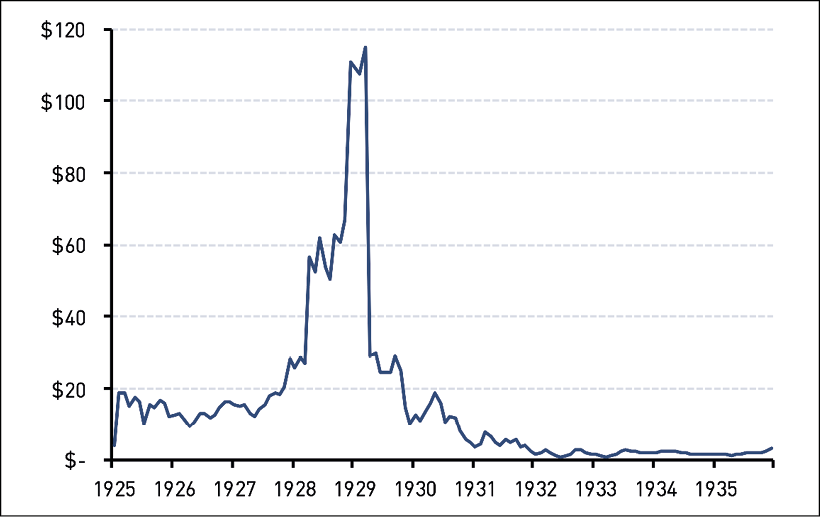
Source: The Wall Street Journal.
The 1930s
The 1930s, the decade of the Great Depression, featured little or even negative economic growth as unemployment reached a st unning 25%.
To address the jobs crisis, the government injected massive amounts of fiscal stimulus into the economy and created programs like the Civil Conservation Corps. But a second leg down in the stock market in 1935 killed any hope of a mid-decad e recovery.
Meanwhile, the stock market was still considered a place only for speculators, not investors. By the end of the decade, the Wall Streeters yachts wer e also gone.
The 1940s and 1950s
During these two decades, there was still little interest in the stock market and trading was very light. The public was out of the market. In the mid-1940s, corporate earnings started to improve because of the stimulus provided by defense spending during Wor ld War II.
Due to the continuing lack of interest in stocks, valuations had become attractive, as P/E multiples of most stocks dropped to historic lows. The overall market was selling at 10x earnings, and the dividend yield was 5%. The attractive valuations had investors gradually coming back i nto stocks.

